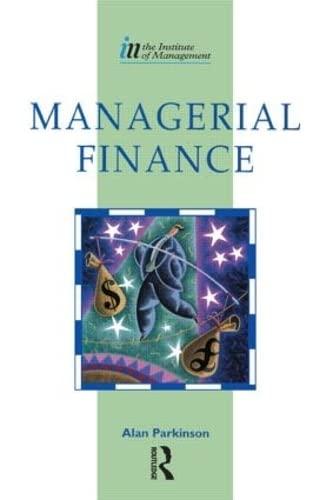Question
Estimating Share Value Using the DCF Model Following are forecasts of Whole Foods sales, net operating profit after tax (NOPAT), and net operating assets (NOA)
Estimating Share Value Using the DCF Model Following are forecasts of Whole Foods sales, net operating profit after tax (NOPAT), and net operating assets (NOA) as of September 25, 2016.
| Reported | Horizon Period | |||||
|---|---|---|---|---|---|---|
| $ millions | 2016 | 2017 | 2018 | 2019 | 2020 | Terminal Period |
| Sales | $15,724 | $15,881 | $16,199 | $16,523 | $16,853 | $17,022 |
| NOPAT | 526 | 524 | 535 | 545 | 556 | 562 |
| NOA | 3,466 | 3,500 | 3,570 | 3,642 | 3,715 | 3,752 |
Answer the following requirements assuming a discount rate (WACC) of 6%, a terminal period growth rate of 1%, common shares outstanding of 318.3 million, and net nonoperating obligations (NNO) of $242 million. (a) Estimate the value of a share of Whole Foods' common stock using the discounted cash flow (DCF) model as of September 25, 2016.
Rounding instructions:
Round answers to the nearest whole number unless noted otherwise.
Use your rounded answers for subsequent calculations.
Do not use negative signs with any of your answers.
| Reported | Forecast Horizon | |||||
|---|---|---|---|---|---|---|
| ($ millions) | 2016 | 2017 | 2018 | 2019 | 2020 | Terminal Period |
| Increase in NOA | Answer | Answer | Answer | Answer | Answer | |
| FCFF (NOPAT - Increase in NOA) | Answer | Answer | Answer | Answer | Answer | |
| Discount factor [1 / (1 + rw)t ] | (Round 5 decimal places) | Answer | Answer | Answer | Answer | |
| Present value of horizon FCFF | Answer | Answer | Answer | Answer | ||
| Cum. present value of horizon FCFF | $Answer | |||||
| Present value of terminal FCFF | Answer | |||||
| Total firm value | Answer | |||||
| NNO | Answer | |||||
| Firm equity value | $Answer | |||||
| Shares outstanding (millions) | Answer | (Round one decimal place) | ||||
| Stock price per share | $Answer | (Round two decimal places) | ||||
(b) Whole Foods stock closed at $30.96 on November 18, 2016, the date the 10-K was filed with the SEC. How does your valuation estimate compare with this closing price? What do you believe are some reasons for the difference?
Stock prices are a function of many factors. It is impossible to speculate on the reasons for the difference.
Our stock price estimate is only a few cents lower than the Whole Foods market price, indicating that we believe that Whole Foods stock is accurately priced.
Our stock price estimate is lower than the Whole Foods market price, indicating that we believe that Whole Foods stock is overvalued. Stock prices are a function of expected NOPAT and NOA, as well as the WACC discount rate. Our lower stock price estimate might be due to more optimistic forecasts or a lower discount rate compared to other investors' and analysts' model assumptions.
Our stock price estimate is lower than the Whole Foods market price, indicating that we believe that Whole Foods stock is undervalued. Stock prices are a function of expected NOPAT and NOA, as well as the WACC discount rate. Our lower stock price estimate might be due to more optimistic forecasts or a lower discount rate compared to other investors' and analysts' model assumptions.
Step by Step Solution
There are 3 Steps involved in it
Step: 1

Get Instant Access to Expert-Tailored Solutions
See step-by-step solutions with expert insights and AI powered tools for academic success
Step: 2

Step: 3

Ace Your Homework with AI
Get the answers you need in no time with our AI-driven, step-by-step assistance
Get Started


